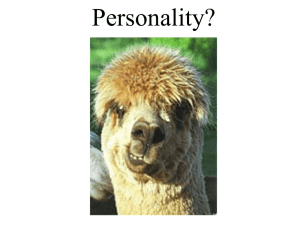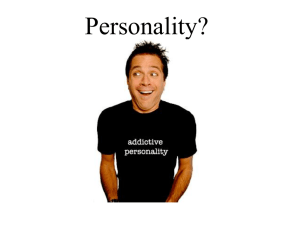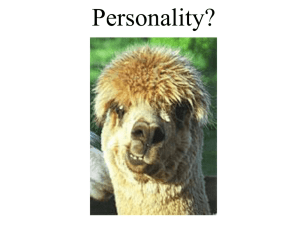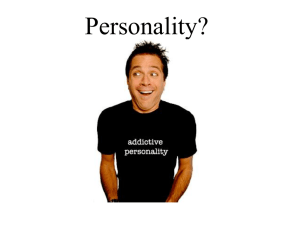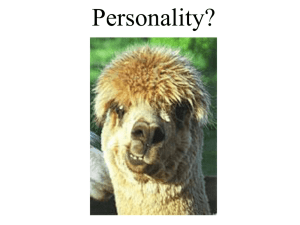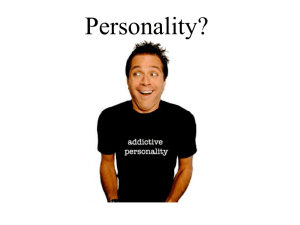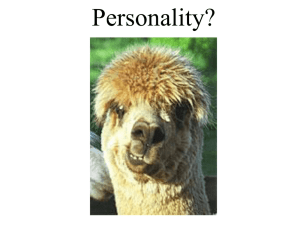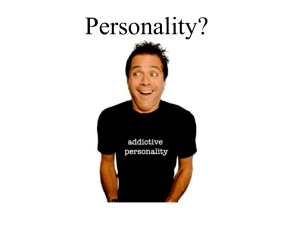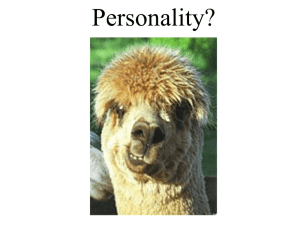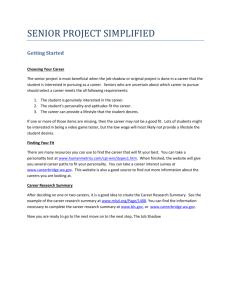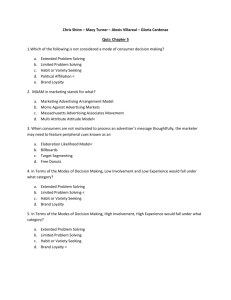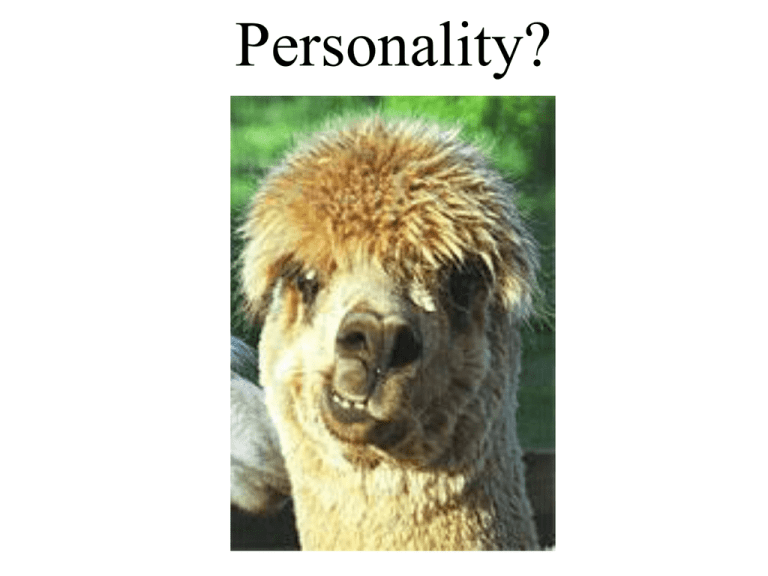
Personality?
Personality
influences how
we respond to
the environment
Idealist
Traditionalist
Realist
Hedonist
One way marketers try to use personality variables is to
link product benefits with consumer personality type
Personality Type
Desired Auto Benefit
Extroverted
Freedom
Warm
Enjoyment
Affiliative
Tradition
Subdued
Relaxation
Introverted
Compromise
Cool
Control
Freudian Theory
Pleasure
Principle
Sexual
Symbolism
Reality
Principle
Id
Id desires pleasures (sex)
Ego
Superego says its socially
unacceptable
Key
Concepts
Superego
struggle between
Id (pleasure),
Superego (reason) and
Ego (moderates between Id
and Superego)
Ego says I’ll find a socially
acceptable way (i. e. symbolic
sex)
so that Superego is happy
and Id can have its pleasure.
Marketing Applications
Products symbolically satisfy consumers sexual needs --substitute the product for the real thing
Others focus on male-oriented symbolism - the phallic symbol.
Do Phallic Symbols in Advertising Really exist or
is it a coincidence?
Why does advertising use sex
as an appeal to the consumer?
Because it works.
Sex is the second strongest of
the psychological appeals,
right behind self-preservation.
Sexual desire’s strength is
biological and instinctive.
For many products it is possible
to find (or invent) a sexual
connection.
The effectiveness of sex
in advertising is gender
linked.
Men have minimal
criteria for sexual desire
Basically, they are
concerned with a woman's
anatomy -- as long as a
woman looks young enough
and healthy, she is
desirable.
in advertising it is easy to
get a man's attention by
using women's bodies and
associate getting the
woman if he buys the
product.
Often female models are placed in
sexually exploitative and
compromising positions, sexually
submissive postures, and with
sexually connotative facial
expressions.
Media definitions of sexual
attractiveness promote either
extreme thinness or a thin waist
with large hips and breasts
The sexual connection is much
easier to set up for men than for
women.
Hanes Resilience" 1996
It’s not just women who
are demeaned in using sex
in advertising, there is a
school of advertising that
says men's bodies, brains
and self-esteem are
legitimate targets to
attack, exploit and belittle
(no pun intended).
Radio Band of America
“As her date removed his
pants, Sheila suddenly
recalled a hilarious radio
show she’d heard that
morning. Later, when
pressed she’d admit the
timing was unfortunate”
The use of sex in advertising to women is more difficult
Although the use of healthy, fit men may attract their
attention and create desire, willingness to engage in
intercourse is rarely aroused strictly because of a man's
body
For a
woman, sexual
desire is a
complex
mixture of
such factors as
money, power,
prestige, etc
To sell to a woman, advertising relies on the modern
idea about how men and women relate -- romance.
Although an ad may use a man's body as an attention getting
device, he is usually shown in a romantic rather than sexual
context.
Motivational Research
Why do women
tend to increase
their expenditures
on clothing and
personal
adornment
products as they
approach the age
of 50 to 55?
Motivational Research
assumes unconscious motives influence consumer behavior
research tries to identify these underlying unconscious forces
(e.g., cultural factors, sociological forces).
Marketers can therefore better understand the target audience
and how to influence that audience.
Qualitative as opposed to quantitative
standard marketing research survey can’t reveal these motives
Three major techniques
1. Observation
2. Focus Groups
3. In-Depth Interviews
Mr. Apple
Brand personality:
He's always been
super bright about
computers, and a
high achiever at the
University. But he's
totally cool and
down to earth, with
a subtle sense of
humour. Not a nerd
at all. But witty,
fun, and creative.
20, maybe early 30
something years
old. Masculine, but
sensitivee
Mr IBM
Brand personality:
Formal and
professional.
Perhaps a bit stiff,
or "square." But
tops in his class
intellectually. He's
gone to the best
University, with an
advanced degree.
And he has very
polished social
skills. 40ish years
old. Masculine,
perhaps a bit
macho.
BRAND PERSONALITY
The type of person the brand
represents
The Quaker Oats man is a
paternal archetype conveying
old-fashioned goodness and
shrewdness
A trustworthy, dependable,
conservative personality might
reflect characteristics valued in a
financial advisor, a lawn service,
or even a car
Quaker Oats 1886
How do you feel about
these brands?
What’s their
personality?
5 Major Brand Personalities
Sincerity: Down-to-earth, family oriented, genuine, old-fashioned.
E.g. Hallmark, Kodak, Coke. The relationship might be similar to
one that exists with a well-liked and respected member of the family.
Excitement: Spirited, young, up-to-date, outgoing. E.g. Pepsi.
Competence: Accomplished, influential, competent. E.g. HewlettPackard, Globe & Mail. Relationship might be similar to one with a
person whom you respect for their accomplishments, such as a
teacher, minister or business leader.
Sophistication: Pretentious, wealthy, condescending: E.g. BMW,
Mercedes, or Lexus (with gold trim) as opposed to the KIA, or the
VW bug. The relationship could be similar to one with a powerful
boss or a rich relative.
Ruggedness: Athletic and outdoorsy. E.g. Nike, Head.
Brand Relations
The relationship between the brand-as-person and the
customer, is analogous to the relationship between two
people.
A brand's personality must reflect the perceptions,
motivations, and values of its targeted customers
One important relationship for many brands is friendship.
Characterized by trust, dependability, understanding,
and caring
A friend is there for you, treats you with respect, is
comfortable, is someone you like, and is an enjoyable
person with whom to spend time.
Dodge Neon
Your friend
Nokia: A Trusted Friend
Motorola
"We call this human
technology"
Intelligence
everywhere
Respect Segment
"My job is to help you get
accepted."
"You have good taste."
Intimidated segment
"Are you ready for me, or will you spend more than you can afford?”
"If you don't like the conditions, get another card."
"I'm so well known and established that I can do what I want."
"If I were going to dinner, I would not include you in the party."
What Creates a Brand Personality?
Packaging, advertising,
marketing activities
Consumers’ experience with
brand
The creation and
communication of a
distinctive brand personality
is one way marketers can
make a product stand out
from the competition
The Logo as a Face
when you see the
same logo time and
time again, it
becomes familiar,
like a familiar
human face
you experience a
sense of recognition,
"Hey, I've seen you,
I know you
BRAND EQUITY
1. the total value of a brand as a
separable asset
2. a measure of the strength of
consumers’ attachment to a
brand
3. The strength of the positive
associations and beliefs the
consumer has about the brand
What is a lifestyle?
Lifestyle Components
People
Setting
Product
Products are the building blocks of lifestyles
consumers choose particular products and services and
activities over others because they are associated with a certain
lifestyles
people use products to define lifestyles
For this reason marketing strategies try to position a product
by fitting it into an existing pattern of consumption or setting
Life Style Marketing
people of similar social and
economic circumstances
share common lifestyles and
patterns of consumption.
Lifestyle marketing recognises that
people sort themselves into groups based
on the things they like to do
Lifestyle marketing looks at patterns of behaviour to
understand how they make their choices in a variety of
product categories - in context
Products are used in desirable social settings or contexts
marketing strategies try to position a product by fitting it into an
existing pattern of consumption
What products go with this lifestyle?
Product Complementarity
An important part of lifestyle
marketing is to identify the set
of products and services that go
together
different products are related
to each other symbolically
these sets of products, termed
consumption constellations
A Consumption Constellation
for the Yuppie Lifestyle
A cluster of complementary
products, specific brands,
and/or consumption activities
used to construct, signify,
and/or perform a social role”
By choosing distinctive
product groupings laden with
symbolic meaning, consumers
communicate their affiliation
with a positively valued, or
aspirational, lifestyle.
From this perspective, the
meaning of a product depends
on the context in which it is
displayed or used
Consumers buy on the basis
of product complementarity
Marketer should understand consumers' cross-category
associations
Why is Knowledge about lifestyles is
important for Marketers?
defining the target market (beyond demographics)
new product development,
cross-merchandising
promotional and media strategies
creating a new view of the market
better communicating product attributes/benefits - to
match a person's lifestyle.
reaching consumers
A manufacturer of bathroom
accessories wishing to license
a line of sportswear products
needs to know
1. how its brand image in the
sportswear category will
translate into purchases of
linens.
2. what linen styles will appeal
to its sportswear customer,
3. the optimal way to display
these items at retail
4. how best to advertise these
products in the appropriate
lifestyle context.
Psychographics
the use of psychological,
sociological and anthropological
factors to construct market
segments
based on differences in
choices of consumption activities
Demographic information tells
us WHO buys
Psychographics tells us WHY
they buy
Activities, Interests and Opinions (AIO)
Psychographic segmentation groups consumers
according to their lifestyles
activities, interests and opinions are one way of
measuring people’s lifestyles
Lifestyle is then boiled down by discovering
1. how people spend their time.
2. what they find interesting and
important and
3. how they view themselves and
the world around them
VALS (Values and Lifestyles)
categorizes consumers into 8
mutually exclusive groups based on
their psychographics and several key
income related demographics.
highlights factors that motivate
consumer buying behavior.
The primary VALS type represents
your dominant approach to life. The
secondary classification represents a
particular emphasis you give to your
dominant approach.
http://www.sricbi.com/VALS/presurvey.shtml
Use VALS to:
•Identify WHO to target
•Uncover WHAT your target group buys and does
•Locate WHERE concentrations of your target group lives
•Identify HOW best to communicate with your target group
•Gain insight into WHY the target group acts the way it does
VALS has been applied to:
•New product/service design
•Marketing and communications
- Targeting
- Product positioning
- Focus group screening
- Promotion planning
- Advertising
•Media Planning
•On-line advertising design and implementation
LIFESTYLE TRENDS
Society's priorities and preferences are constantly changing
Essential for marketers to both track and anticipate them
Needham's longitudinal lifestyle study since 1975
Found that in late 1990s Americans wanted, in essence, gain
without pain.
TEN LIFESTYLE TRENDS
1. Unhealthy eating
People are paying less attention to nutrition and diet.
For more than 10 years, the percentage of people who make an
effort to increase their vitamin intake or fibre content and reduce
additives, cholesterol, salt, sugar, and fat has fallen rapidly.
people say they may want to eat more healthfully, the reality is
people are moving in the opposite direction.
2. Fitness
More than 50% of American men and women think they're in
good physical condition.
That percentage has been falling for more then 20 years.
While people indicate that exercise is a good idea, most are doing
little about it.
Most forms of exercise have declined as regular activities
3. Environmental issues
End of the 1980s, 70% said they would support pollution
standards, even if it means shutting down some factories.
End of 1990s number is starting to fall.
End 1970s more than 60% said they would accept a lower
standard of living to conserve energy.
End 1990s numbers have dropped drastically.
People may wish to be environmentally conscious, but the truth is
they're moving in the opposite direction.
4. Traditional values
85% indicate they have "somewhat old-fashioned tastes”
But an increasing number support the legalization of marijuana,
believe couples should live together before marrying, etc.
pendulum is swinging toward "satisfying one's self,”
people will "embrace traditional values only as long as they don't
interfere with convenience, practicality, or individualism."
5. lack of discretionary time
With less time to comparison shop, consumers are limiting choices
to stores they know carry the correct sizes and colours and have
adequate stocks of sale items .
Emphasis on Time-saving products e.g. pre-cooked foods, prepared foods drive through pizzas
6. Dual-income families are becoming single-income families:
has created opportunities for telecommuting, part-time work and
home-operated businesses.
also an increased demand for home-improvement centres
With one income, families shop more in discount stores.
7. Nostalgia
For many, our high-tech, materialistic world is too stressful.
Consumers seek connections with past when things were simpler
Companies can connect with consumers by helping them
remember and re-live the past.
8. Increased focus on quality of life
More causal work environment, relaxed dress code
home entertainment
travel industry
spirituality
9. Mass Customization
mass customization is about choice; about giving consumers a
unique end product when, where and how they want it.
mass-market goods and services individualized to satisfy a
very specific customer need, at an affordable price.
Based on the consumers desire
for "custom-made", or
personalized products but at mass production prices
More product variety: Since 1985 number of car models
gone from 140 to 260; soft drinks from 20 to 90. Today., U.S. market
offers 3,000 brands of beer, 50 brands of bottled water, 340 kinds of
cereals, 70 styles of Levi's jeans.
10. Technohome
integration of technology into appliances
Internet Lifestyle
experience includes a home
with new levels of comfort,
convenience, and security to
consumers through Internetenabled devices and services
for communication,
entertainment, family
management, home control,
and personal commerce.

